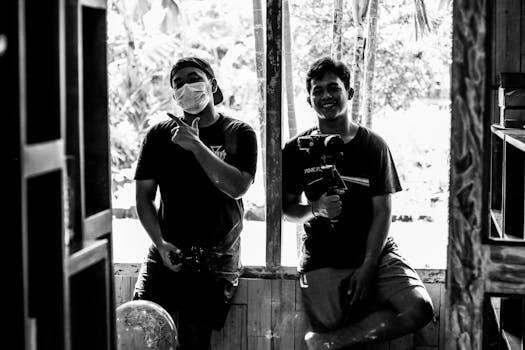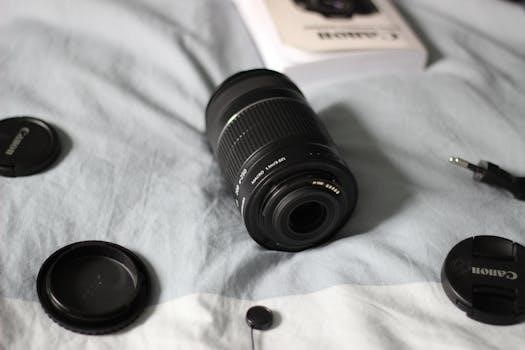Canon 80D Manual Overview
The Canon EOS 80D user manual is a comprehensive guide‚ providing instructions on operating the camera. It includes a quick start guide‚ basic operations‚ advanced features‚ menu functions‚ and custom settings. The manual covers troubleshooting‚ specifications and is available as a downloadable PDF file. This resource is essential for understanding the 80D’s capabilities.
Canon 80D User Manuals
The Canon EOS 80D user manuals are essential resources for both new and experienced users. These manuals‚ available in PDF format‚ provide detailed instructions on every aspect of the camera’s operation. You can find various versions‚ including basic instruction manuals and more comprehensive guides that cover advanced techniques. These documents explain the camera’s features‚ from initial setup to intricate settings adjustments. They act as a reference for navigating the menu system and understanding the purpose of each button and dial. The manuals often include troubleshooting tips and are available in multiple languages‚ including English and Russian. Many online platforms offer free downloads of these manuals‚ making them easily accessible to anyone who needs them. They are indispensable tools for getting the most out of your Canon EOS 80D. These manuals are also available for download directly from Canon’s website‚ ensuring you have the most up-to-date version. Whether you’re looking for a quick start guide or an in-depth explanation of a specific feature‚ the user manuals are your best resource. Always refer to the official manual for the most accurate information.
Downloading the Canon 80D Manual
Downloading the Canon EOS 80D manual is a straightforward process. The primary source for obtaining the manual is the official Canon website‚ where you can find the most current version. Typically‚ the manual is available in PDF format‚ making it easy to access on various devices. To begin‚ navigate to the support section of Canon’s website and search for the EOS 80D model. Look for the “Manuals” or “Downloads” section‚ where you’ll find the user manual listed. Clicking on the download link will initiate the process‚ allowing you to save the file to your computer or mobile device. Numerous third-party websites also host the manual‚ however‚ using the official Canon site ensures you have the most accurate and updated information‚ and also that it is free from any malicious software. Ensure you choose the correct language version for your ease of use. Once downloaded‚ the manual can be viewed offline‚ allowing you to refer to it whenever you need guidance. Always be sure to download the file from a trusted source.

Key Features and Operation
The Canon EOS 80D boasts a 24.2 MP APS-C CMOS sensor and DIGIC 6 processor‚ ensuring high-quality images. Its Dual Pixel AF allows for fast and accurate focusing in video and Live View. External buttons and dials provide intuitive control‚ and the menu system offers customization.
Understanding External Buttons and Dials
The Canon 80D is equipped with numerous external buttons and dials‚ each designed for specific functions to enhance the user experience. It is important to familiarize yourself with these controls to efficiently operate the camera. The Main Dial‚ located on top of the camera‚ is frequently used for changing settings‚ as is the Quick Control Dial found on the rear. The ‘Q’ button provides quick access to shooting settings on the LCD screen. Pay close attention to the Mode dial‚ which allows you to switch between various shooting modes such as aperture priority‚ shutter priority‚ manual‚ and automatic. Dedicated buttons like ISO‚ AF‚ and metering mode provide direct access to critical settings. There are also buttons for image playback‚ menu navigation‚ and display options. The multi-controller allows for quick navigation through menus and image browsing. Understanding the specific function of each button and dial is key to mastering the 80D and maximizing its capabilities. Utilizing these controls effectively will streamline your workflow and allow for quick adjustments in various shooting situations. The comprehensive user manual offers detailed explanations for each control.
Navigating the Menu System

The Canon 80D’s menu system is a comprehensive hub for customizing camera settings‚ but can be a little complex. Navigating effectively is crucial for taking full advantage of the camera’s capabilities. The menu is organized into several tabs‚ often represented by different colored icons such as camera‚ playback‚ and setup. To access the menu‚ press the “MENU” button‚ which brings up a list of options on the LCD screen. Use the multi-controller or the Quick Control Dial to move through the menu items and select the desired setting. The camera settings are generally located under the orange camera icon‚ whereas playback settings are represented by a blue arrow. Custom functions are found within their designated menu area. When adjusting settings‚ be aware of the submenus and options within each category. The user manual provides detailed explanations of each setting and its effects. Familiarizing yourself with the menu structure will allow for quick adjustments‚ enabling you to make the most of your 80D in various shooting situations. Remember to save any changes you make. The menu system also provides access to the camera’s wireless functionality;
Basic Operations Guide
Understanding the Canon 80D’s basic operations is essential for capturing great photos and videos. Start by familiarizing yourself with the main external controls‚ including the Mode dial‚ Main Dial‚ and Quick Control Dial. The Mode dial allows you to switch between shooting modes like Auto‚ Program‚ Aperture Priority‚ Shutter Priority‚ Manual‚ and various scene modes. The Main Dial‚ located near the shutter button‚ is often used to adjust aperture or shutter speed‚ depending on the shooting mode. The Quick Control Dial on the rear of the camera is used to make adjustments while looking at the LCD screen‚ such as changing ISO or white balance. To take a photo‚ half-press the shutter button to focus and then fully press it to capture the image. The ‘Q’ button provides quick access to common shooting settings. The camera also has a dedicated button for accessing the menu system for more in-depth adjustments. The user manual is essential for gaining a deeper understanding of these basic operations. Practice these controls to become comfortable with the camera’s functions.

Advanced Techniques and Settings
The Canon 80D offers advanced techniques like Auto Exposure Bracketing‚ custom function settings‚ and wireless functionality. These features allow users to fine-tune their photography‚ explore creative possibilities‚ and connect seamlessly with other devices. The user manual provides detailed information on using these capabilities effectively.
Auto Exposure Bracketing (AEB) Explained
Auto Exposure Bracketing (AEB) on the Canon 80D is a powerful tool for capturing images with a wide dynamic range. It involves taking multiple shots of the same scene‚ each with a different exposure level. The camera automatically adjusts the shutter speed or aperture to create these variations. Typically‚ three shots are taken⁚ one at the metered exposure‚ one underexposed‚ and one overexposed. These images can later be combined in post-processing to create a High Dynamic Range (HDR) image‚ revealing detail in both the highlights and shadows. The bracketing settings are found within the camera’s menu system‚ specifically under the orange camera icon‚ and offer customization options. Understanding the bracketing menu is crucial‚ as there are several settings that affect how AEB behaves. While the full user manual is needed for a detailed explanation of each setting‚ it’s important to note that bracketing affects exposure and can be used for artistic purposes. Experimentation and a careful study of the manual are essential for mastering this feature.
Custom Function Settings
The Canon 80D offers a range of Custom Function settings‚ allowing users to personalize their camera’s behavior to suit their specific needs and shooting style. These settings‚ often abbreviated as C.Fn‚ provide advanced control over various aspects of the camera’s operation. These settings allow users to modify button functions‚ adjust autofocus behavior‚ and customize exposure control. For instance‚ you can reassign the function of buttons‚ change the behavior of the mirror lock-up‚ or enable specific autofocus modes. The settings are accessed through the camera’s menu system‚ and a full understanding of each option requires a close study of the user manual. The specific location of these settings can be found under the orange camera icon in the menu. The Custom Function menu allows photographers to enhance the usability of their 80D. These settings provide flexibility and tailored functionality to capture the perfect shot. The full user guide contains detailed information on each of these customizable options.
Wireless Functionality
The Canon 80D offers built-in wireless functionality‚ allowing users to connect the camera to other devices such as smartphones‚ tablets‚ and computers. This wireless feature enables remote control of the camera‚ live view monitoring‚ and the transfer of images and videos. The 80D utilizes Wi-Fi technology‚ and in some cases‚ NFC for quick pairing with compatible devices. The camera’s wireless settings are accessed through the menu system‚ where users can configure connection preferences and establish links to other devices. The user manual provides detailed instructions on setting up and using these wireless features. The 80D allows users to share their images or control the camera remotely. The user manual will also explain any limitations or important information related to wireless use in other countries or regions. The 80D offers a seamless wireless experience. The full user guide explains all the steps for proper wireless operation.

Troubleshooting and Support
Canon provides extensive support for the EOS 80D‚ including drivers‚ software‚ firmware‚ and user manuals. These resources help users address common issues and ensure optimal camera performance. Online support and downloadable files are available to assist with any troubleshooting.
Finding Drivers‚ Software‚ and Firmware
To ensure your Canon EOS 80D operates at its best‚ it’s crucial to keep its drivers‚ software‚ and firmware updated. Canon provides these resources on their official website‚ readily accessible for download. Start by navigating to the support section of the Canon website and locate your specific camera model‚ the EOS 80D. Here‚ you’ll find a dedicated page offering a variety of downloads including the latest camera drivers which ensure proper communication between your camera and computer‚ allowing for seamless image transfer and software compatibility. Additionally‚ you’ll find software updates and Canon’s Digital Photo Professional (DPP) software‚ which can enhance your post-processing workflow. Firmware updates are also available‚ which often improve camera performance‚ fix bugs‚ and add new features. Always ensure you download the correct files for your operating system (Windows or macOS) and follow Canon’s instructions for installation. Keeping your EOS 80D up-to-date will allow you to utilize the full potential of your camera‚ ensuring both optimal performance and longevity. Regularly check the Canon support page for new updates.
Common Issues and Solutions
Users of the Canon EOS 80D may encounter some common issues. One frequent concern is difficulty changing aperture and shutter speed in manual mode‚ which often stems from incorrect mode dial settings or custom function configurations. Ensuring that the camera is indeed set to ‘M’ mode is the first step. Another issue can be the camera not focusing correctly‚ which could result from selecting the wrong focus mode or using a dirty lens. Regularly cleaning the lens and checking focus settings are important. Wi-Fi connectivity problems can also arise‚ often because of incorrect password entries or network issues; resetting camera network settings and checking router configurations can help. Software or driver conflicts when connecting to a computer can occur‚ which can be resolved by updating software or drivers. If the camera freezes or behaves erratically‚ a simple battery removal and reinsertion may help. It’s crucial to refer to the user manual for detailed troubleshooting steps and to ensure that all settings are appropriate for the specific photography needs.
